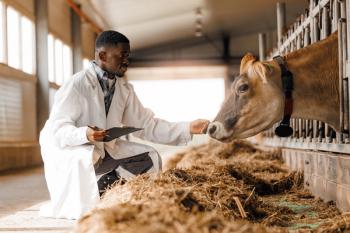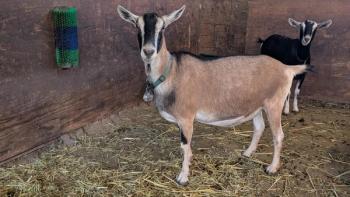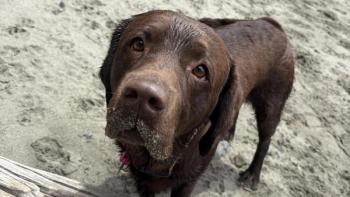
Noncore vaccines: which ones and how often? Part 1 – dogs (Proceedings)
Practitioners may choose to vaccinate with most or all of the vaccines available, with the belief that prevention is better than treating the disease.
Classification of canine vaccines
Practitioners may choose to vaccinate with most or all of the vaccines available, with the belief that prevention is better than treating the disease. In the 1960s through the early 1980s, this practice was common and quite easy, as the only vaccines available were DHLPP and rabies. Today there are more vaccine products, new antigens, different combinations, and even different disease patterns than in the past. It is now virtually impossible to vaccinate every dog with every available product. To address this increase in number and complexity, vaccines are now categorized as core, noncore, and not recommended. As the names imply, vaccines that all dogs should receive are core, while noncore are optional based on lifestyle, local disease prevalence, and risk/benefit ratios. The third category of "not recommended" has proven to be controversial, as some common vaccine products that are actively marketed by vaccine companies are now discouraged.
Core vaccines include distemper, parvo, adenovirus type 2, and rabies. Vaccines classified as noncore and not recommended are discussed below.
Noncore vaccines
Parainfluenza virus (CPIV)
The 2006 AAHA Canine Vaccine Guidelines changed CPIV from "recommended" to "noncore", presumably because the disease caused by the virus (usually a self-limiting cough) is mild. The parenteral (injectable) MLV vaccines are given to puppies at the same schedule as CDV, CAV-2, and CPV as they are only sold in combination. Topical (intranasal) MLV vaccines are marketed in combination with Bordetella with or without CAV-2. Very few studies have been performed on CPIV infection or the protection offered by vaccines. One study demonstrated protection from challenge 13 months after intranasal vaccination with Bordetella and parainfluenza. Dogs at risk of exposure should ideally be vaccinated with an IN products at least one week prior to boarding, traveling, etc. A 3-year revaccination interval is recommended after a puppy series and a 1-year booster.
Bordetella bronchiseptica (Bb)
This vaccine is available as a live avirulent bacterin for topical (intranasal) use or as a parenteral (injectable SC) cell wall antigen extract. Bb causes infectious tracheobronchitis ("kennel cough") which is often mild and self-limiting but occasionally can lead to pneumonia or other severe complications. As a noncore vaccine, dogs at risk of exposure should be vaccinated.
The topical products should be given as a single dose according to label instructions (as early as 3 weeks of age depending on type). A second dose can be given 2-4 weeks later for best results. Annual revaccination is recommended or even more often in high-risk animals. A booster is suggested 1 week before exposure if more than 6 months has elapsed since the last Bb vaccine. Duration of immunity is at least 12-13 months based on two studies. There are no studies suggesting extended intervals such as every 3 years. Transient coughing, sneezing, or nasal discharge is occasionally seen as a post-vaccination adverse reaction.
Injectable Bb vaccine is recommended for puppies at 8 and 12 weeks of age followed by annual revaccination. In high-risk environments, every 6 months is suggested as a booster interval. As with IN vaccines, a booster is helpful given 1 week before exposure. There is no benefit in vaccination with both IN and SC on the same day. However, giving both products in sequence every 2 weeks was shown in one study to provide excellent protection (the injectable vaccine used in that study is no longer available). Dogs previously vaccinated or exposed to the "kennel cough" organisms may have high antibody levels and sufficient immunity that makes "boosters" questionable as to efficacy.
Leptospirosis
This disease does not appear to be a threat in all areas but incidence has been increasing in the U.S. The risk of contracting lepto is assumed to be from exposure to wildlife or even urban pests such as squirrels, mice, and rats. Rainfall and moist conditions appear to increase the incidence. Many more dogs are exposed than become clinically ill, and asymptomatic dogs may shed lepto spirochetes in the urine. For at-risk puppies and dogs, one vaccination at 12 weeks followed by a second at 14-16 weeks is recommended. Annual boosters, or even at 6-9 month intervals for high exposure situations, are recommended. There is currently no evidence of long DOI. In one study of a bivalent vaccine (L. interrogans serovars canicola and icterohaemorrhagiae), dogs were protected 56 weeks after vaccination at 9 and 13 weeks of age.
Currently, two products include additional serovars (pomona and grippotyphosa) (Duramune 4/L, Fort Dodge and 4L, Pfizer). Recent studies suggest that these two serovars are responsible for most of the clinical disease diagnosed rather than the original serovars found in all lepto vaccines. However, because of cross-reactivity in diagnostic assays, the exact serovar causing an infection is speculative (based on high Ab titer responses) rather than proven. Practitioners often ask if leptospirosis is a problem in their practice area and whether routine vaccination is worthwhile. The risk:benefit ratio is somewhat different for lepto vaccines than for other products, as adverse reactions in puppies, toy breeds and small dogs is more common. Because there is no central reporting database for veterinarians to refer to, questions about prevalence in an area should be directed to diagnostic labs at nearby veterinary schools or state facilities. If practices with large caseloads are seeing clinical leptospirosis, or if labs in the area are diagnosing positives, then vaccination is recommended. Otherwise, lepto may be safely omitted from routine protocols. No vaccine is 100% protective and there is a potential for infection by other serovars not covered in the vaccines (such as bratislava and autumnalis).
Lyme disease (Borrelia burgdorferi, borreliosis)
Several types of vaccines are currently available, including whole cell bacterins, recombinant-outer surface protein A (rLyme or OspA) products, and bacterins containing OspA and OspC. Lyme disease is considered endemic in parts of the Northeast and upper Midwest, and also occurs in the Pacific Northwest and eastern seaboard. Some areas of the country are free of Lyme disease unless humans or animals have traveled to other areas. The noncore status is likely due to this geographic limitation along with the fact that Lyme disease is nonfatal and treatable (with the exception of Lyme nephritis, an emerging complication).
Puppies at risk are vaccinated at 9 to 12 weeks of age followed by a second dose 2-4 weeks later (manufacturer recommendations should be followed). Annual revaccination, preferably just before tick season, is recommended. Extended DOI are not appropriate. Only a minimum 1 year protection from challenge has been shown.
There is much debate over the usefulness of Lyme disease vaccines, especially in seropositive dogs (those that have a positive Ab titer to Borrelia due to previous exposure). In endemic areas, the majority of dogs are seropositive but asymptomatic. Some experts recommend avoiding Lyme vaccine in any dog testing positive for Ab. Other experts feel it may help both with current disease and as protection against future infections. Further research is needed to clarify this issue. There is a consensus that tick control is at least as important as vaccination in Lyme-endemic areas.
Vaccines not recommended
Coronavirus (CCV)
In both the 2003 and 2006 Guidelines, CCV is not recommended for puppies or adult dogs. This is in contrast to the popularity of CCV vaccines, usually given in combination with core antigens. The reason for the widespread use of this vaccine despite little evidence of its usefulness or efficacy is the result of advertising and marketing. Clinical CCV disease occurs rarely and is mild and self-limiting. Neither MLV nor killed vaccines have been conclusively shown to reduce disease caused by CCV. Also, efficacy and DOI cannot be accurately determined as studies performed to date have failed to show evidence of significant disease in either vaccinates or control dogs. Veterinarians who have discontinued CCV vaccination in their practices have not reported an increase in infectious enteritis. Extensive literature searches have failed to find research studies or publications supportive of CCV as a serious illness or the need to vaccinate.
Giardia lamblia
This killed vaccine may reduce shedding of cysts in infected dogs but does not prevent infection. Routine use is not recommended but may be considered in affected dogs. Followup testing is important to determine if vaccination results in less clinical disease or reduction of cyst shedding.
Unclassified vaccines
Canine influenza
A new vaccine for influenza H3N8 was conditionally licensed by the USDA in 2009. The virus is suspected to be a mutation of the equine influenza virus, and is not directly related to canine parainfluenza or human influenza. First reported in Greyhounds in 2004, canine influenza has spread to many areas of the country and is now a ruleout for any dog presenting with upper respiratory disease (fever, cough, runny nose). As this is a new pathogen, virtually all exposed dogs will become infected, with 80% showing clinical signs and 20% remaining asymptomatic. The mortality rate of affected dogs is reported to be 5-8%, while 10-20% have severe complications such as pneumonia. The diagnosis can be difficult, as the disease appears similar to other causes of infectious tracheobronchitis (Bordetella, parainfluenza, adenovirus type 2, herpes, corona, Mycoplasma, etc.). Several reference labs offer antibody titer testing (two samples taken 2-3 weeks apart are needed) or PCR for the viral antigen. Treatment is supportive.
The influenza vaccine is a killed virus, and can be given to healthy dogs 6 weeks of age or older. A booster 2-4 weeks later is needed. Annual revaccination is recommended. At this time, the prevalence of canine influenza is unknown but if cases have been diagnosed in a practice area, vaccination should be considered for dogs at risk of exposure. Most likely influenza will not be a core vaccine intended for all dogs unless the disease continues to spread causing significant morbidity and mortality. Other influenza viruses have recently been identified in dogs, including avian types H5N1 and H3N2.
Periodontal disease vaccine
One conditionally licensed product is available to stimulate immunity to bacteria involved in gingival and periodontal infections in dogs. The Porphyromonas Denticanis-Gulae-Salivosa bacterin is approved for the vaccination of healthy dogs as an aid in preventing periodontitis, as demonstrated by a reduction in bone changes (osteolysis/osteosclerosis). Two vaccinations are given 3 weeks apart to dogs 7 weeks of age or older, but the revaccination (booster) interval is unknown. Field studies are ongoing but data have not been published. Efficacy in dogs already affected with periodontal disease is unknown, as the vaccine is designed to prevent disease in healthy dogs.
Rattlesnake vaccine
This product has been available for several years and is designed to prevent severe signs in dogs associated with envenomation, Two vaccines are given one month apart. Annual revaccination in the spring or one month before risk of exposure (e.g. before a hunting trip) is recommended. The vaccine is said to protect against venom from Western Diamondback rattlesnakes but only partially protect against Eastern Diamondbacks. There is no effect against cottonmouth, coral, or Mojave rattlesnakes.
Newsletter
From exam room tips to practice management insights, get trusted veterinary news delivered straight to your inbox—subscribe to dvm360.






